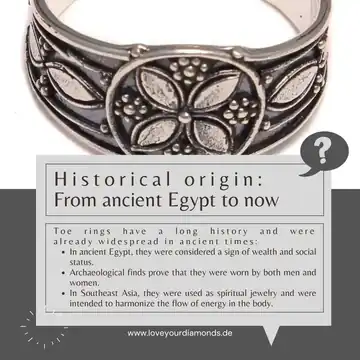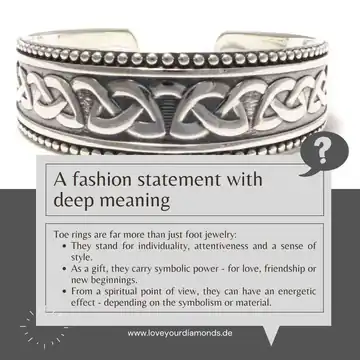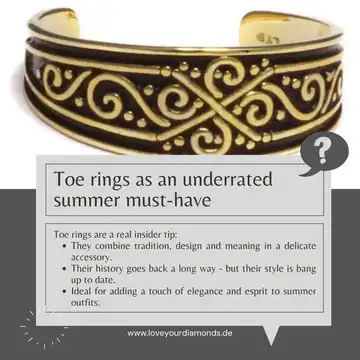The toe ring - a piece of jewelry with a big impact
Is jewelry just for your hands, neck and ears? Jewelry has much more to offer! Because the toe ring is back and wants to be seen! This small, charming accessory is the silent star on the foot and brings just the right amount of sparkle that sandals, flip-flops and barefoot moments deserve. Whether discreet or playful – toe rings show: style knows no foot boundaries :)
Historical origins of toe rings: from pharaohs to modern times
 Toe rings have had an impressive journey through history. Even in ancient Egypt, they adorned not only temple dancers, but also pharaohs – as a sign of wealth and rank. Archaeologists, for example, found skeletons over 3,300 years old with elaborately crafted copper alloy toe rings, including a male specimen – a clear indication that foot jewelry was by no means a gender-specific status symbol back then.
Toe rings have had an impressive journey through history. Even in ancient Egypt, they adorned not only temple dancers, but also pharaohs – as a sign of wealth and rank. Archaeologists, for example, found skeletons over 3,300 years old with elaborately crafted copper alloy toe rings, including a male specimen – a clear indication that foot jewelry was by no means a gender-specific status symbol back then.
In India, toe rings – called bichiya – have been an integral part of the culture since Vedic times. Married women traditionally wear them on their second toe as a symbol of marriage, fertility and female energy. However, men also used them in certain regions as a spiritual symbol or to emphasize their social status. The materials - from iron to gold - reflected not only taste but also status.
Toe rings were also widespread in Southeast Asia, often artistically designed and charged with spiritual meaning. Among other things, they were intended to harmonize the flow of energy in the body and strengthen inner balance.
What was once worn by kings, dancers and healers alike can now be worn with pride by all genders. Toe rings celebrate individuality, cultural diversity – and prove that style can literally start with the toes.
Back to top
Toe rings in Indian culture: symbolism and health
 In Indian culture, toe rings are a meaningful symbol that goes far beyond fashionable aspects. Married women traditionally wear them on the second toes of both feet – as a visible sign of their marriage, comparable to a wedding ring. This ritual has deep roots in love, fertility and family ties.
In Indian culture, toe rings are a meaningful symbol that goes far beyond fashionable aspects. Married women traditionally wear them on the second toes of both feet – as a visible sign of their marriage, comparable to a wedding ring. This ritual has deep roots in love, fertility and family ties.
The toe rings not only stand for fidelity, but are also considered a symbol of female energy. They are said to harmonize the menstrual cycle and promote fertility. In many regions of India, it is an indispensable custom for brides to receive a pair of these rings at their wedding – usually made of silver, as this metal is considered cooling and healing.
Toe rings also have a special significance from an Ayurvedic perspective. They specifically stimulate certain reflex zones that are connected to the uterus and abdomen. They are not only intended to strengthen emotional balance, but also promote physical well-being – a combination of tradition, symbolism and holistic health.
Toe rings in the West: fashion, freedom and lifestyle
Toe rings were particularly popular in Europe in the 1960s and 70s, when travel to India and spiritual influences from the East became increasingly important. Inspired by Indian jewelry traditions, hippies and free spirits initially wore the filigree rings on their toes. During this time, they became a symbol of individuality and cultural openness.
Toe rings have become particularly popular among yogis, esoterics and followers of the boho lifestyle. The combination of naturalness, spiritual symbols and handmade jewelry fits perfectly with the ideals of this scene. Toe rings not only stand for aesthetics, but also for a conscious attitude to life in harmony with the body and nature.
Toe rings are making a stylish comeback as a summer fashion accessory. In combination with sandals, barefoot on the beach or as the highlight of a festival look, they create subtle accents. Whether minimalist or with ornaments – they round off summer outfits with ease and charm.
Back to top
Fashion statement with spiritual depth
 Toe rings have long been more than just a summer accessory – they are a subtle expression of individuality and personal style. Those who wear them consciously set accents, pay attention to detail and express their attitude to the world in a small piece of jewelry. At a time when self-care and inner balance are becoming increasingly important, such pieces represent conscious decisions.
Toe rings have long been more than just a summer accessory – they are a subtle expression of individuality and personal style. Those who wear them consciously set accents, pay attention to detail and express their attitude to the world in a small piece of jewelry. At a time when self-care and inner balance are becoming increasingly important, such pieces represent conscious decisions.
Toe rings also have a special effect as a gift. They convey a personal message and express appreciation in a charming way. Depending on the symbol or design, they can symbolize love, friendship or a new stage in life – small gestures with great expressiveness.
Spiritually speaking, toe rings are associated with certain energy points in the body. Many people attribute a harmonizing or even protective effect to them. In combination with certain symbols or precious metals, pieces of jewelry with deep meaning and energetic potential are created.
Back to top
Conclusion: toe rings as a must-have for the summer
Toe rings deserve far more attention than they have received so far. They are delicate pieces of jewelry with great style potential that enhance any summer outfit. Despite their discreet size, they attract admiring glances.
Their history goes back to ancient cultures, where they often carried a symbolic meaning. Today, they combine tradition with modern designs and become an expression of individuality and self-confidence. Anyone who wears toe rings shows courage for detail and a love of the extraordinary.
So why stop at the ankle? Style knows no boundaries – especially not when it comes to jewelry. Toe rings invite you to design your own look right down to the toe. A small statement that reveals a lot about your personality.
Back to top
Frequently asked questions (FAQ) about toe rings
 What is a toe ring?
What is a toe ring?
A toe ring is a delicate piece of jewelry designed especially for the toes. It is often worn on the second toe and is a stylish accessory, especially in summer. Toe rings can be plain, decorated or designed with symbols.
What is the significance of a toe ring?
Depending on the culture, a toe ring can have different meanings. In India, it symbolizes love, fertility and marriage for married women. Spiritually, it is often ascribed an energetically harmonizing effect. In the West, it primarily stands for individuality, fashion awareness and summer lifestyle.
What material are toe rings made of?
Toe rings are often made of 925 sterling silver, stainless steel, copper or gold. In India, silver is traditionally used as it is considered cooling and healing. It is important that the material is skin-friendly and comfortable to wear - especially in summer.
How to wear a toe ring correctly?
Toe rings are usually worn on the second toe, as this is particularly stable due to its position. Depending on the design, they are available open (adjustable) or closed in fixed ring sizes. They should fit comfortably without pinching or slipping.
 Toe rings to match any outfit?
Toe rings to match any outfit?
Yes, toe rings can be wonderfully combined with summery outfits. They look particularly good in sandals, flip-flops or barefoot on the beach. They complement boho, festival or beach looks and add subtle but stylish accents.
Do toe rings have a spiritual effect?
In some cultures, toe rings are attributed a spiritual or energetic meaning. According to Ayurveda, they stimulate certain reflex zones on the foot that are associated with reproductive organs or inner balance. Spiritual symbols on the ring can also have an additional effect.
Are toe rings only for women?
No, toe rings were historically worn by both sexes – for example by pharaohs in ancient Egypt. Today, they are suitable for anyone who values detail, symbolism or stylish foot accessories. Toe rings celebrate diversity and individuality – regardless of gender.
Back to top